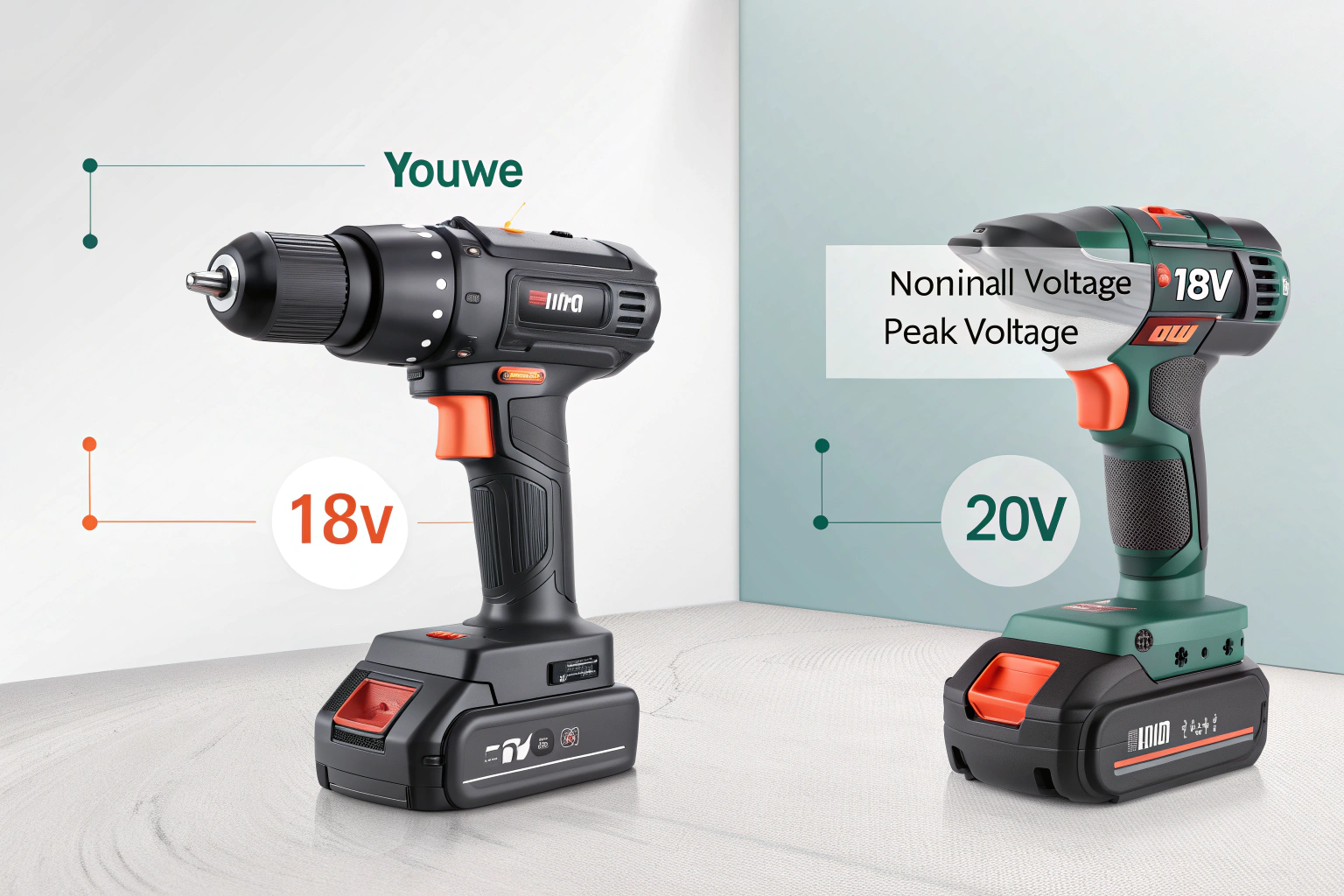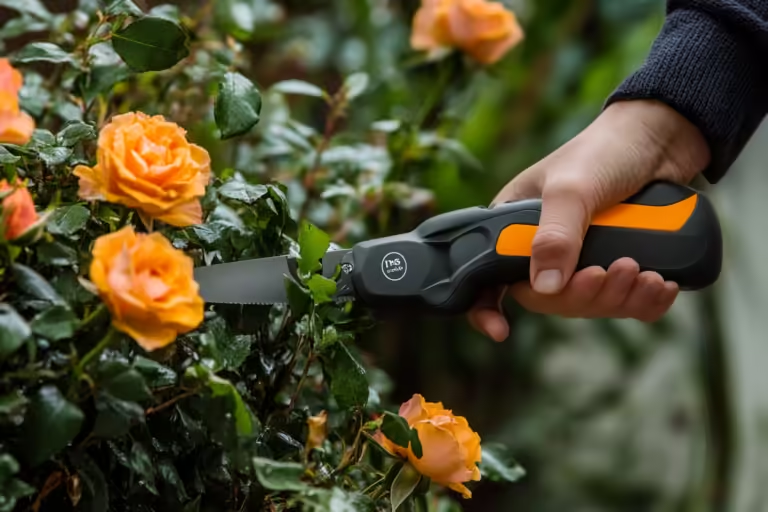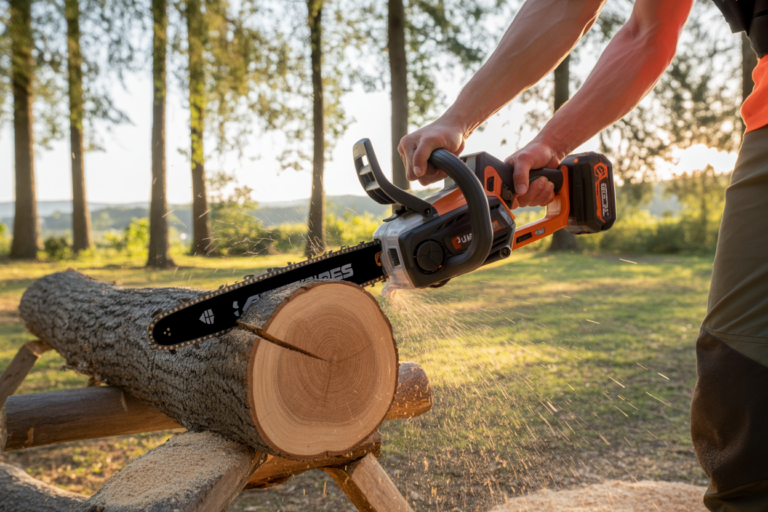Corded drills used to dominate the tool world—but once I switched to cordless, especially 21V ones, everything changed.
Most cordless drills range from 12V to 21V, with higher voltage meaning more power. For professional or OEM buyers, 18V and 21V offer better versatility and torque.

I’ve worked with dozens of procurement managers across Europe and South America. One common thing I hear: “We want reliable lithium tools, but many options are underpowered or overpriced.” That’s exactly why I push our 21V cordless line—it fills that gap. Let me explain how.
What is the difference between 18V and 20V drills?
Everyone asks this—sometimes even seasoned buyers. The voltage rating sounds different, but is it?
Technically, there is no real difference between 18V and 20V drills. The 20V refers to the peak voltage when fully charged, while 18V refers to the nominal operating voltage.

Why the confusion?
Most 20V tools use the same cells as 18V ones—usually 5 lithium-ion cells at 3.6V nominal and 4.0V max. Some brands market them as 20V to sound more powerful.
But here's what actually matters for buyers:
| Feature | 18V / 20V (same cell) | YOUWE 21V |
|---|---|---|
| Nominal Voltage | 18V | 18.5V – 20V |
| Max Voltage | 20V | 21V |
| Compatibility | Varies by brand | Customizable for OEM needs |
| Torque Output | Moderate | High (ideal for heavy-duty) |
| Branding Flexibility | Usually fixed | Fully OEM-friendly |
I’ve had a Turkish client ask why their “20V” drill1 felt weaker than another labeled 18V. After testing both, we found the torque rating2 and cell quality made the real difference—not the number on the box.
If you're not sure which features really matter in a cordless drill, I wrote a detailed guide on key drill features that breaks it all down. Read about how different tools perform at exhibitions in this article
Is a 12V drill enough for home use?
This comes up a lot, especially from retailers or buyers looking to fill entry-level shelves.
Yes, a 12V cordless drill is enough for light home use like assembling furniture or drilling into drywall, but it struggles with dense wood or masonry.

When is 12V too weak?
Some of our clients initially wanted to offer budget 12V sets. But they came back weeks later with complaints:
- Drill bits stuck in pine boards
- Users couldn’t finish small concrete mounting jobs
- Batteries drained faster under repeated use
For most importers focused on D.I.Y markets, the solution is not just lower price—it’s lower returns. That’s why I recommend our 21V set. It’s light enough for daily use, but strong enough to power through hard wood, brick, and ceramic tile.
What size drill is best for home use?
When buyers ask about “size,” they’re usually mixing up chuck size, weight, and power.
The best size drill for home use is compact, around 10mm or 13mm chuck size3, with enough torque to cover wood, metal, and light masonry jobs.
Let’s break it down:
✅ Chuck Size
- 10mm: great for light-duty and compact tools
- 13mm: better for more versatility—what we use on our 21V drills
✅ Weight
- Lighter than 2kg with battery
- Good balance between portability and control
✅ Voltage
- 18V or above is ideal for covering 90% of household needs
We designed our cordless drill kits4 with exactly this in mind. In fact, one client in Brazil told me their biggest headache was users returning 12V kits because “it wouldn’t drill through a kitchen wall.” After switching to our 21V DIY set5, returns dropped by over 70%.
To understand how we make these drills meet high durability standards, check out our production process breakdown.
What is better, brushed or brushless cordless drills?
This is a classic tradeoff buyers must consider—price vs performance.
Brushless drills are better than brushed ones in terms of lifespan, efficiency, and torque—but they cost more.
The real deal:
| Motor Type | Pros | Cons |
|---|---|---|
| Brushed | Lower price | Wears out faster, less efficient |
| Brushless | Higher efficiency, quieter, longer life | Higher cost |
For example, we offer both versions in our 21V drill line:
- For D.I.Y markets, our brushed drills hit the sweet spot between cost and reliability.
- For industrial or pro users, the brushless version cuts down heat, saves battery, and lasts longer.
One Italian distributor I spoke to said, “We tried selling cheaper brushed models, but clients now expect brushless even for home tools.” That’s a market shift we can’t ignore.
Which is better, a 12 volt or 18-volt cordless drill?
This is a key question for any procurement decision. Especially when buying at scale.
An 18V drill is more versatile and powerful than a 12V drill. It handles tougher tasks, supports bigger bits, and lasts longer under load.
Let’s look at real-world use:
| Task | 12V Drill | 18V Drill |
|---|---|---|
| Furniture Assembly | ✅ | ✅ |
| Drywall Anchoring | ✅ | ✅ |
| Drilling into Wood Studs | ⚠️ | ✅ |
| Masonry or Brick | ❌ | ✅ |
| Hole Saw / Large Bits | ❌ | ✅ |
That said, I always remind buyers—voltage isn’t the only thing. Torque, battery capacity, and motor efficiency matter too.
And that’s exactly why we built our YOUWE 21V series—to outperform 18V but stay within the same weight class. You get more torque, longer run-time, and full OEM branding flexibility.
One client even said, “It feels like a 24V drill in an 18V body.” That’s the kind of feedback I love hearing.
🛠 Recommended Reading
-
How to Find a Quality Wholesale Electric Drill Supplier for Your Brand
A complete checklist to choose reliable, flexible OEM factories. -
What Are Key Features of Cordless Drills?
Don’t just look at voltage—these are the features that matter most. -
What is the production process of the cordless drill?
Step-by-step view of how a lithium drill gets made.
Conclusion
Voltage is just a number—what really matters is matching the drill to your users’ needs and offering a product that performs reliably across tasks.
-
Explore this resource to understand the real differences and features that matter when choosing a drill. ↩
-
Exploring torque ratings will help you understand how they impact the efficiency and effectiveness of your drilling tasks. ↩
-
Discover why 10mm or 13mm chuck sizes are ideal for home drills, ensuring versatility and efficiency in your projects. ↩
-
Explore this link to discover top-rated cordless drill kits that balance power, size, and versatility for all your DIY needs. ↩
-
Learn how a 21V DIY set can enhance your drilling experience, providing power and reducing tool returns. ↩







